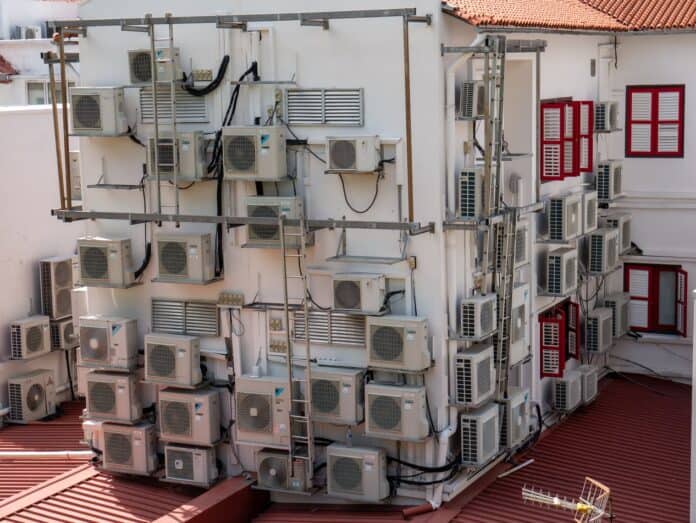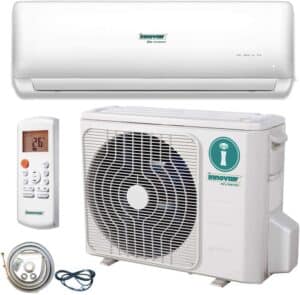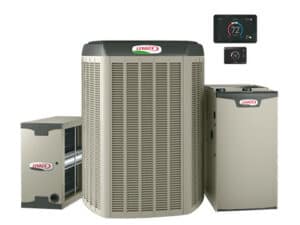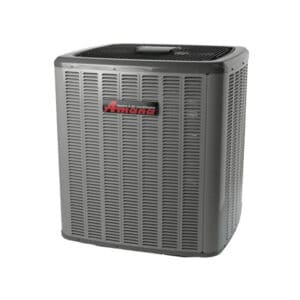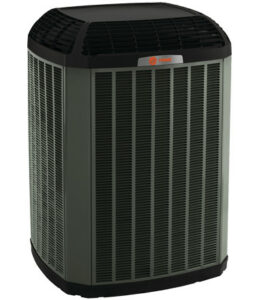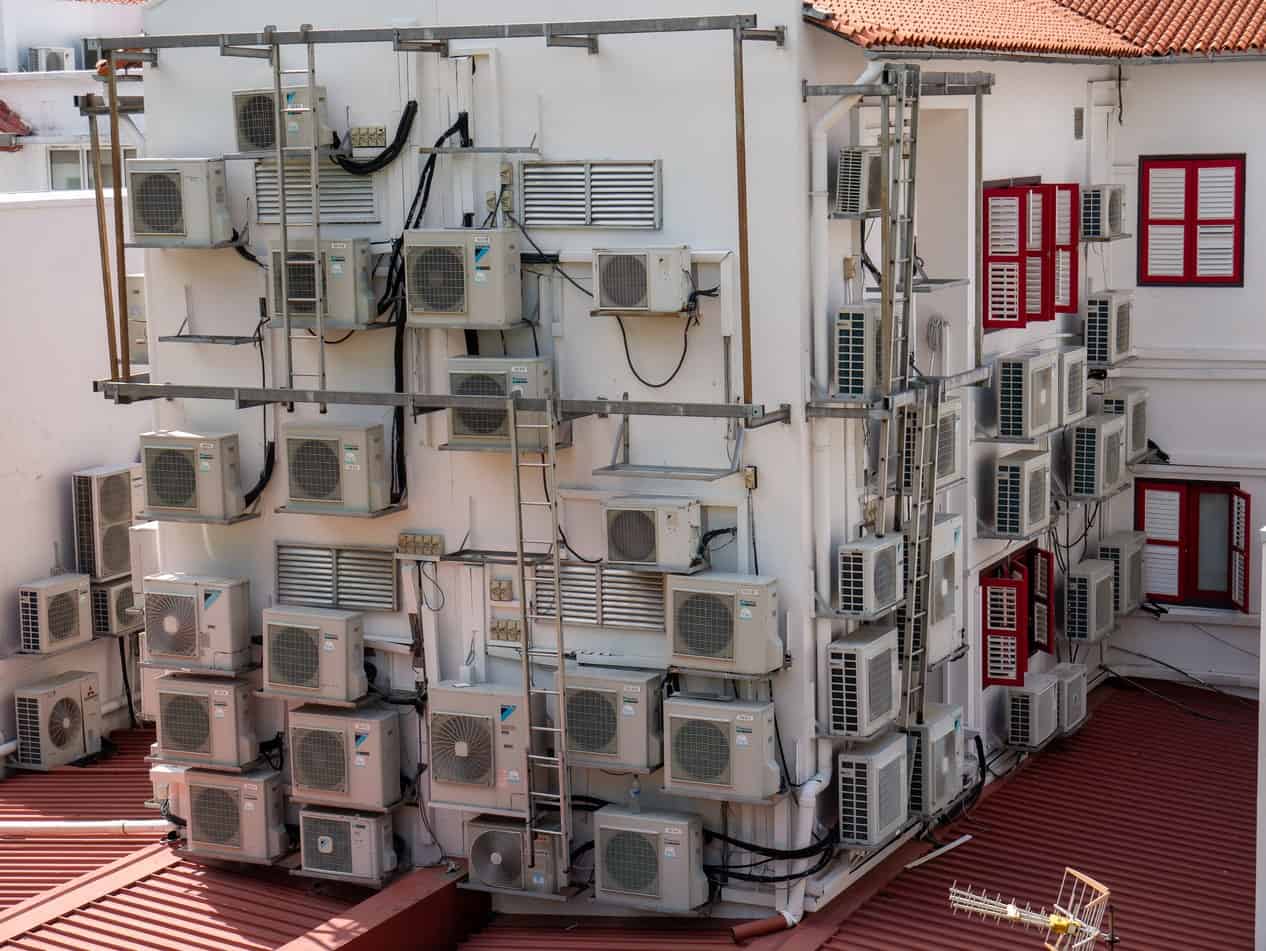In this post, you will be guided with the step-by-step procedure on how to come up with buying the right air conditioner matching your needs. So, keep reading!
Whether for your home or office, looking for the right air conditioner isn’t an easy thing. Instead, it would help if you were extra careful to find the best one. And because air conditioning plays a vital role in your place, choosing the one that would suit your cooling needs matters a lot. So, better follow the right path leading to the best air conditioner.
Let’s get into the steps to buying the right air conditioner.
Table of Contents
Step 1. Choose the right type of air conditioner.
Of course, there isn’t just one air conditioner, but there are different types that you should consider. Are you familiar with these various types? If not, here they are, along with reviews of the top options you can choose from:
Window Air Conditioners
This one is the most common room air conditioner designed for double-hung windows. It is straightforward to install and also easy to remove. It pulls in the hot air from the room and runs it over the cooling coil before returning, blowing it back to the office. You can install this type of air conditioner permanently if you want to.
The window air conditioner is best for people who want to enjoy cold air only in the cheapest way. For example, it could cool a single room. You can choose from these top picks:
-
LG LW8016ER Window Air Conditioner
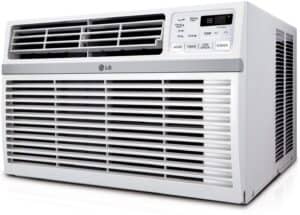
This window air conditioner can cool a room of 340-square-foot, and it has energy-saving features, along with plenty of settings you would love.
For example, LG LW8016ER Window Air Conditioner has an 8000 BTU rating and could dehumidify a room by almost 2.2 points per hour. So said, this will not just make your room cooler, but it could also take some of the stickiness out.
Pros
Cons
-
Friedrich Chill Series CP08G10B Window Air Conditioner
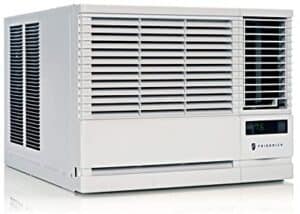
Another great option to consider is the Friedrich brand, which ranges in BTU rating from 5200 to 24000 BTU. You can find one for your room, whether 150 square feet or 1400 square feet.
You could get around a clock timer to program run times, and the four-way air-flow control regards control. Friedrich Chill Series CP08G10B Window AC comes with a remote control to change the fan or temperature setting.
Cons
-
LG 115V Dual Inverter Smart Window Air Conditioner
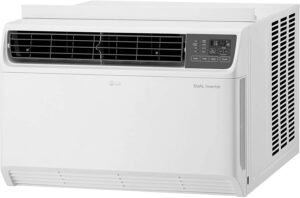
This window air conditioner comes in various sizing that ranges from 14000 BTU up to 22000 BTU making it so powerful to cool rooms from 800 to 120 square feet. It could cool your entire living space if you live in a studio or a one-bedroom apartment.
LG 115V Dual Inverter Smart Window AC is also an efficient option as it lowers the electricity bill by almost 25%. In addition, it has four cooling and fan speeds, and it features the Auto Cool function, which optimizes cooling. Plus, it features a 24-hour timer to set a schedule for when you want the air conditioner to be off and on.
Pros
Cons
Through the Wall Air Conditioner
Another type of air conditioner is the wall air conditioner. This one is similar to window units; however, you install it through a wall instead of a window. Again, the unit would come with a sleeve used to support the unit’s weight inside the wall.
It is a good option for people who want to use the existing windows while having a cheap air conditioning system. Its newer technology allows it to give off more cooling power as well.
Here are some of the best picks:
-
Koldfront Through the Wall Air Conditioner
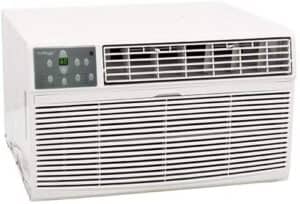
This amazing air conditioning system, created by Koldfront, comes with remote control intended for easy operation, like changing speeds or turning the unit on and off. It has three fan speeds and 4-way air directional louvers plus 4 operation modes.
Koldfront Through the Wall AC also features a sleep function to adjust the temperature and return it to the set after 6 hours.
Pros
Cons
-
Keystone Follow Me LCD Remote Control Through-The-Wall Air Conditioner

With Keystone Follow Me LCD Remote Control Through-The-Wall AC, cleaning the filter is easier than ever. There is just a need for you to pull out its filter, rinse and dry it.
Or you could use a vacuum to eliminate all the dust. This, through the wall, the air conditioner also features multiple options. It has 3 pre-programmed fan speeds and 3 cooling modes too.
You can also save a lot on electricity costs because of the Energy-saver mode or the Auto Option to ramp up and down the fan speed. The remote control also has a thermostat, so you can always adjust the temperature anytime.
Pros
Cons
-
Emerson Quiet Kool Through the Wall Air Conditioner
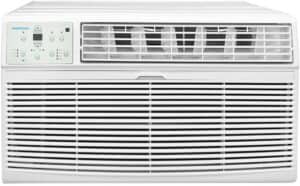
This is an impressive option because of the programmable timer and sleep mode. Its sleep mode could always adjust its temperature, ensuring you are comfortable at night. It could also let you save a lot of energy. The programmable 24-hour timer could also be easily set with its remote control, onboard controls, voice controls, or tablet or phone app.
Emerson Quiet Kool Through the Wall AC lacks noise and keeps the house quiet. Two air exhaust vents could be combined with the 3 fan speeds and help you achieve the 8-way flexibility.
Pros
Cons
Portable Air Conditioner
Mobile and portable. The Portable air conditioner is a floor system, particularly with wheels, which cools rooms by removing the heat from the air and dehumidifying it, returning the air a lot cooler into the same space. It is an air conditioner intended for homes wherein building regulations or window configurations prevent the installation of window units.
Some best options are the following:
-
Whynter 14,000 BTU Dual Hose Portable Air Conditioner (ARC-14S)
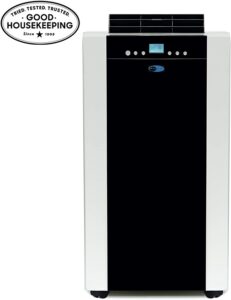
This one offers a bit large BTU of 14000, making it capable of cooling more space, like over 700sq.ft. It works in a way that requires no room air to work with a condenser. Its dual hose design also makes it better than the single hose system since it lets its own air circulation.
Whynter 14,000 BTU Dual Hose Portable AC saves you the stress of having to drain the water buckets. The unit is engineered to automatically drain water exhausted from the room air and save you both manual labor and time. This is referred to as the Auto-Evaporation System. Plus, this unit is very flexible because of the thermostat and the 24-hour remote control.
Pros
Cons
-
Honeywell MN10CESBB 10,000 BTU Portable Air Conditioner

This is another great option for portable air conditioner type. It is a new cooling appliance with modern features having a full-function remote control to operate the unit even from a distance. It also comes with a 10000 BTU that can cool a room with a size of 400 square feet.
Honeywell MN10CESBB 10,000 BTU Portable AC works as a humidifier too. It dehumidifies at about 75 pints of water daily in a moist environment. It also has a programmable timer or a caster wheel, which aids mobility, and an auto-drain system, draining the water through the evaporation system.
Pros
Cons
-
Shinco 10,000 BTU Portable Air Conditioner
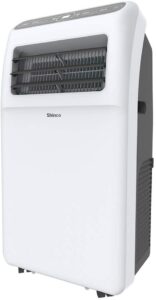
This portable air conditioner pick comes with 10000 BTU, which could keep the temperature of an area at about 300 square feet cool. In addition, it boasts its self-diagnostic function, which could automatically diagnose itself and let you be guided on how to fix the problem.
Shinco 10,000 BTU Portable AC unit works as an auto-evaporation system, which could automatically recycle the water exhausted from the room air and saves you from manual labor. Also, this one is designed with an anti-freezing system that would prevent the unit from forming ice.
Pros
Cons
Ductless Mini-Split Air Conditioner
This one is considered the most famous of all the other devices because of its high-efficiency mechanisms. This unit would give you the best features for your money. Ductless Mini-Split Air conditioners usually operate by having a main outdoor system with multiple mini hubs throughout the home to deliver cooling throughout.
It features a wall-mounted coordinated system that allows every room to be climate controlled, intended for maximum flexibility. It is also extraordinarily quiet and low profile. As a result, it could be placed in special strategic locations in the home.
Here are some options for this unit:
-
PIONEER WYS020GMHI22M2 Air Conditioner
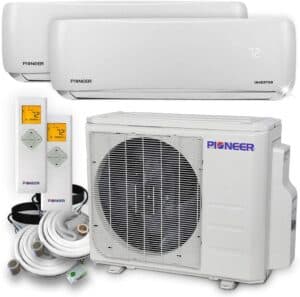
PIONEER WYS020GMHI22M2 AC is indeed an option with superb features and a unit that is meant to last long. The unit features a small design and a hidden LED display intended to ease monitoring. You could meet your various cooling and even heating needs. The manufacturer also offers an excellent warranty on different parts of the unit
Pros
Cons
For a versatile model, this one is your best choice. Innovair Mini-Split AC is considered one of the finest mini-splits in the market today, and it is famous for being an all-rounder. The said product comes with various modes to serve superb efficiency. It is also ETL-certified, which enhances its reliability. Furthermore, the unit boasts a user-friendly design allowing you to make certain adjustments by utilizing a wireless remote control.
Pros
Cons
-
Senville SENL-24CD Mini-Split Air Conditioner
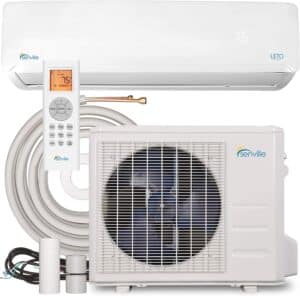
This unit offers 24000 BTU and 15 SEER rated, making it capable of cooling a huge room or even a higher ceiling than normal. Moreover, it has a respectable BTU rating indeed. And Senville SENL-24CD Mini-Split AC also operates on 220 VAC, and it uses an R410A refrigerant. Plus, the unit is also equipped with a heat pump.
Pros
Cons
Central Air Conditioner
And finally, this one could be your best whole-home solution. The central air conditioner pumps cool air through ducts to every room in the building. This type might be expensive, but it is much more convenient. This type also keeps the entire house cool. Along with zone controls, it combines the convenience of a whole house system with localized controls of portable and window ACs.
Also, it includes thermostats in every room so you can precisely manage the temperature anywhere. And this versatility could be handy for sunny or poorly insulated rooms.
And for your options, consider the following:
Lennox Signature Series XC25 AC is considered the most efficient split-system central air conditioner having a 26 SEER rating. It easily integrates with solar to reduce the need for energy generated by coal-fired plants. A 10-year limited warranty covers all its parts.
Pros
Cons
These models are tied not just in terms of efficiency but also the same. Amana AVXC20 & Daikin DX20VC ACs have a higher SEER rating and are variable-capacity air conditioners. In addition, inverter technology is top-notch, and great warranties are also available. For example, Amana would offer a lifetime warranty on its compressor and a 12-year unit replacement warranty on Daikin.
Pros
Cons
This is another cost-effective solution if you are looking for high SEER units. Its generic parts could be fitted, making this a great choice for the majority. It is also average in terms of noise performance. The installation is also easy, so you wouldn’t worry much about it.
Pros
Cons
Step 2. Physical and Structural Restrictions
Of course, now that you are familiar with the different types of air conditioners and already have top options to pick from, don’t forget that there are still many factors to consider. Next in line is to consider both the physical and structural restrictions.
Here’s what you should know:
Physical Space
Take note that several issues might happen if you put an air conditioner too powerful for the room in which it is placed. The unit would alternate between cycling on and off a lot often. Some of these issues include:
- high levels of humidity in the room
- consume higher amounts of electricity, early wear, and tear of the machinery
Also, the room might not be properly cooled if the unit is underpowered and too small. It might as well increase energy costs. So, choosing an air conditioner’s suitable size is best by measuring the room or space you intend to place the unit in.
Air Conditioner Size
To determine the right size of the air conditioner, you need a measuring tape. Follow these steps:
- measure the room’s length and width in feet
- multiply the numbers to get the square footage
After this, you can already shop for the right size of AC. But, you still need to match the square footage to the correct BTU of the air conditioner. The higher the BTU number, then the greater the cooling power of the AC.
Structural Restrictions
Based on the type of apartment or house you have, there is a certain legal restriction on the type of AC you could install. For example, some apartment complexes and residential zones might not allow you to install window air units since a part of them hangs out the window.
You might also not install through-the-wall units or ductless mini-splits since these require structural changes to the walls. Well, portable air conditioners are allowed because they don’t hang out the windows, or there is no need for installation.
Step 3. Identify the Short List of Needs
So, what do you exactly need for an air conditioner? Here are sets of questions to consider:
Q: Do you consider heavy installation?
A: Extensive installation might be needed by ductless mini splits, and central air conditioners and professionals must do so. Other types need minimal effort, like portable and window air conditioners.
Q: Do you want an AC that could be moved easily?
A: For some, it is essential to have a cooling unit that could be easily moved and so the portable air conditioner is the only option for this.
Q: Do you want to conserve much energy as possible?
A: If conserving energy is important, then choose a unit that keeps the expenses low. Take note that a central air conditioner is the one that costs most, and the cheapest ones are the through the wall and window air conditioners. Portable and ductless fall in the middle.
Q: How about the level of noise?
A: The decibel scale differs widely in ACs. Central air conditioners are considered the quietest, followed by ductless mini-splits. Air conditioners are a bit tolerable through the wall and window because the noisiest parts are located in another room or outdoors. And portable air conditioners are considered the loudest and could be as loud as vacuum cleaners.
Final Thoughts
Now that you’ve learned important details about the various types of air conditioners, along with options to choose from, and you are as well provided with factors to consider, it is now the time for you to make your final decision on whether which air conditioner is the right one for you. Just don’t forget this guide and happy shopping!

